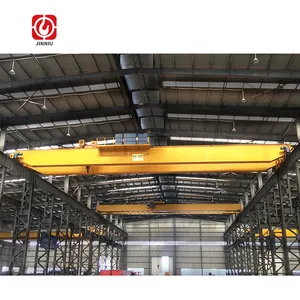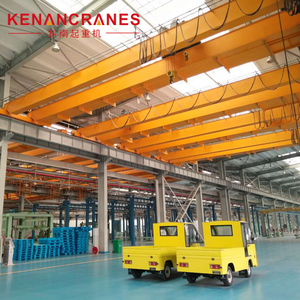
Workstation Overhead Crane Steel Plant 40 Ton 50 Ton Overhead Crane Price Wasting Bridge Handling Crane









Integral to industrial operations, overhead cranes are robust machines engineered for the lifting and maneuvering of substantial and unwieldy loads with precision and facility. These cranes typically consist of a horizontal beam, a lifting hoist, and one or more trolleys that traverse the beam's length. The hoist elevates the load vertically, while the trolley, along with its attached load maintainers, facilitates the crane's lateral movement, enabling the effortless transportation of materials throughout the workspace.
Indispensable in sectors like manufacturing, construction, and shipping, overhead cranes are pivotal for the efficient handling of hefty components or products. Their design often incorporates adjustable speed controls, safety mechanisms, and multiple operational modes to meet diverse handling needs. The operation of overhead cranes merges mechanical leverage with electrical power to safely and dependably hoist and transport heavy objects.
The price of an overhead crane is subject to considerable variation based on its specifications and lifting capacity. For instance, a crane capable of hoisting 50 tons will command a higher price than one with a 5-ton capacity, reflecting the greater structural complexity and componentry required for handling such significant weights. Enterprises in the market for an overhead crane should weigh its capacity, dimensions, and features to ensure compatibility with their specific lifting requirements.
The cost of an overhead crane hinges on multiple factors, including its lifting capacity, crane type (single or double girder), span (the distance between the runway rails), and the requisite lifting height. Below are some prevalent configurations:
Single Girder Crane: Apt for light to moderate lifting duties, this variant features a solitary beam and is generally more economical and compact than its double girder counterparts, making it well-suited for spaces with size constraints or operations that do not demand intensive lifting.
Double Girder Crane: With a superior lifting capability relative to single girder cranes, the double girder models typically boast dual beams, enhancing stability and strength. They are predominantly employed in scenarios where routinely lifting extremely heavy loads is the norm.
Span (Distance between Runway Rails): An overhead crane's span, the horizontal distance between its runways, determines its ability to carry broader loads, an asset in environments where transporting large machinery or materials over considerable distances is required.
Lifting Height: The elevation to which a load must be raised is a critical consideration in crane selection. The runway height and the travel distance of the crane's trolley influence the maximum lifting height achievable, which must be sufficient for the crane's intended use.
Choosing the appropriate overhead crane is a pivotal decision that influences both operational efficiency and safety. When evaluating 50-ton capacity cranes on Alibaba.com, consider the following factors:
Span and Lift Height: Verify that the crane can span the entire work area and attain the necessary height. The span dictates the crane's reach, while the lift height determines the elevation to which it can hoist materials or machinery.
Material Handling Requirements: Reflect on the nature of the materials you intend to move. For example, handling steel coils would necessitate a crane equipped with robust, durable hooks for secure attachment to the coils.
Frequency of Use: Gauge the crane's usage frequency. Operations characterized by high intensity or heavier loads may require a more durable and higher-rated crane.
Environment: The crane's operating environment can significantly impact its performance and longevity. In severe conditions, such as foundries or chemical plants, a crane with corrosion-resistant properties is vital.
Regulatory Compliance: Ascertain that the crane adheres to all pertinent safety standards and regulations within your industry to circumvent legal complications.
By meticulously balancing these considerations with your business's needs while navigating Alibaba.com's extensive selection of overhead cranes, you can make a well-informed purchase that meets your operational demands.
Alibaba.com distinguishes itself as a comprehensive marketplace for businesses in search of dependable and efficient overhead crane solutions, offering a broad spectrum of choices tailored to specific operational needs. From robust double-girder cranes for substantial load handling to nimble single-girder models for lighter tasks, the platform's diverse supplier listings cater to a range of project requirements.
The user-friendly interface of Alibaba.com streamlines the comparison of different products based on their attributes and technical specifications. Its mobile-responsive design ensures seamless connectivity and interaction with suppliers in various languages, facilitating smoother international transactions.
Furthermore, Alibaba.com's dedication to secure trading through services like Trade Assurance instills confidence in businesses when investing in overhead cranes for their operations. This trust, combined with the platform's extensive selection, positions it as an optimal source for acquiring high-quality lifting equipment at competitive prices.
In selecting an overhead crane, factor in the heaviest weight you anticipate lifting. It is essential that the crane's load capacity is ample for your operations to prevent safety risks and to promote the equipment's durability.
The crane's operating environment, whether indoors or outdoors, clean or corrosive, will dictate the choice of materials and protective coatings to endure those specific conditions.
Certain overhead cranes are specifically engineered for outdoor use. Features such as galvanized finishes or components rated for outdoor use are key to ensuring durability and performance in diverse weather conditions.
Consistent inspections for wear and functionality, coupled with regular maintenance as per the manufacturer's guidelines, are crucial for maintaining an overhead crane's performance and safety.
Indeed, there are various overhead crane types, such as gantry cranes, bridge cranes (also known as overhead or overhead travelling cranes), and cantilever cranes, each tailored for specific lifting and maneuvering tasks.
Ensure that only trained personnel operate the crane, with a clear understanding of its capacity and safety features. Regular inspections and adherence to safe lifting protocols are equally essential.
Examine the crane's specifications for its designated use, such as indoor or outdoor operation. Indoor-specific cranes may prioritize quiet operation, while outdoor models require sturdier construction and potentially weather-resistant finishes.
Many suppliers provide customization options for overhead cranes to accommodate unique operational needs, which may include specific dimensions, materials, or added functionalities.
Double girder bridge cranes generally boast higher load capacities and can cover wider spans than single girder bridge cranes, rendering them more suitable for heavier loads and extended travel distances.
Operating an overhead crane on an uneven or unstable surface is inadvisable. The floor must be level and capable of supporting the crane's weight and load as per its specifications.
When choosing a control system, consider the precision needed for your operations, the nature of the load handling, the user-friendliness of the system, and its compatibility with your existing infrastructure.
An overhead crane's lifespan can vary depending on its design, frequency of use, environmental conditions, and maintenance practices. With proper care, it can serve reliably for many years before replacement is necessary.